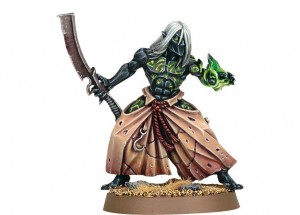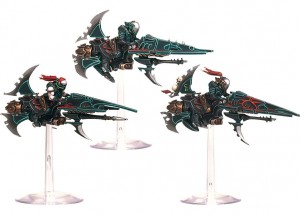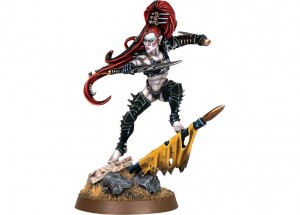While away this summer I missed the launch of 40k Sixth Edition. Tuesday I swung by Redcap’s to pick up a copy of the rulebook in preparation for PAGE on Sunday. These are some of my first, pre-play thoughts. I’ve only skimmed through very very quickly so far, so I’m sure I’ve missed important things and misunderstood or incorrectly analyzed some points below.
The Cover & Art
The cover is pretty solid. That sounds like a trivial concern, but GW definitely screws them up from time to time and it is actually a big part of the general appeal of any ruleset.
This one is very squarely within the tradition of GW covers, particularly those featuring Space Marines, even the heretical ones. It’s not super inspiring to me, but it’s also not filled with lots of amateur perspective errors and such like the latest Blood Angels codex. I like that it doesn’t have any borders, I think it makes it stand out a bit, and I also dig the yellow tint. These guys have a good gallery of all the 40k book covers up until recently. These are the main rulebooks:
-
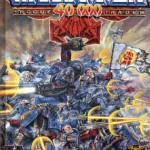
-
1st Edition
-
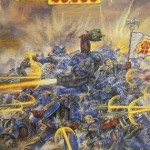
-
2nd Edition
-
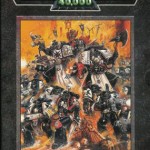
-
3rd Edition
-
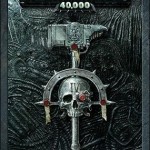
-
4th Edition
-
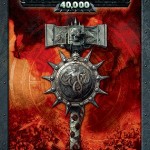
-
5th Edition
-
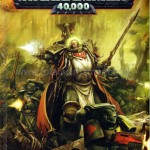
-
6th Edition
Right now I sort of like the more abstract 5th edition cover as the best overall, but I’m pretty sure this is going to grow on me and be just as liked.
In general I really like a lot of the new paintings in the book. They convey well the sense of massive, sprawling, inconceivably chaotic battles. The foldout pages are also kind of interesting though I have to look through those sections more. I have mixed feelings about the photos in the actual rule sections. They look good and are clear in and of themselves, but I think they’re also just a bit distracting from the business at hand on the page.
Pre-Measuring
When I started playing 40k it bothered me tremendously that you couldn’t pre-measure anything. In particulary, it gives more seasoned players a huge boost over new miniatures players. Over time though I grew ok with it, especially as I got pretty good at judging distances.
At this point, I could go either way on this one. It’ll be better for newer players, and though it does take away a skill, I’m not sure the skill was an important one. That said, I’m extremely concerned that pre-measuring will be a real problem in tournament play as it gives a player yet another way to drag out a game and stall to run out the clock.
Wound Allocation
It seems that the wound allocation rules got a lot simpler. Mechanically I thought the 5e rules were pretty ok, but they certainly came across as complex the first time, lead to endless confusion, and a lot of somewhat cheesy manipulation. Simply wounding the closest guys is a lot simpler. Pre-release I saw some people complaining that it’ll be a lot slower, but I don’t think that will be the case in practice. People will identify shortcuts for common situations, while the rules will be nicely formal and clean.
On the one hand I agree that it’s unfortunate that players will go back to hiding their most important models in the back of a group. Hopefully this is mitigated a bit by Precision Shots and Challenges, discussed below. On the other hand, I think forcing an opponent to remove from the front weakens assault units just a little bit. If you have to pull from the front and I manage to wipe out a whole bunch of guys on the front line, then I’ve delayed your assault. Personally I felt assault was a lot more powerful than shooting in 5e, so this kind of chipping away at that imbalance is a good thing.
Overwatch
I was originally excited to hear about Overwatch joining the game, but these rules seem kind of silly. Sure, in a pinch BS 1 attacks might do something, but for the most part I usually wouldn’t even feel they’re worth rolling. In return, the player doesn’t have to make any sort of decision. You would almost never not take advantage of Overwatch, except those very rare occasions when you want to be assaulted, as there’s no downside.
I think it would have been better to have Overwatch be stronger, but have some cost. E.g., forego shooting in the my current turn in order to have the ability to fire Overwatch as normal shooting in the other player’s Movement or Assault phases. That would let me do things like skip some wimpy shooting now, e.g., if I don’t have good line of sight, in order to have good shots when he clusters everybody up at me to assault next turn, or runs a unit across an alley in front of me.
Charge
The changes to charging seem really really really unfortunate. With the addition of pre-measuring, I could see they’d want some randomness in charging. I personally am not convinced it’s necessary, but I could understand. This seems ridiculous though. Two inches through twelve inches is a huge swing. That’s really random. Much worse, counter to the point above, this seems to be a very random but significant boost to assaulting units. Now they have real potential to be mixing it up with your dudes even faster. To mind mind that’s exactly the opposite direction the game needed to go in. Assaults were already overpowered, let alone the least dynamic and most boring part of the game. We’ll see how this plays out in practice, but I’m pretty skeptical.
Our Weapons are Useless
The ability to choose to fail out of combat with something you can’t hurt is a nice little touch for anyone who’s ever been stuck going toe-to-toe with a Greater Demon or old school C’Tan. It’s also a fairly minor buff as it’s a pretty hard thing to use well. I always found the original Space Marine ability to do this very risky to put into play, so I think this is a good addition without changing much.
Multiple Combats
It’s very interesting that units charging multiple targets loses the +1 charge bonus. That’s the kind of debuff Assault needed to balance it out against shooting.
Challenges
The potential problem of units hiding in the back might mentioned above be mitigated a bit by Challenges. There do seem to be potential problems with Challenges though. In particular, it seems like a strong buff to Assault oriented characters, as they can Assault a unit, Challenge its leader, and then not be brought down by a torrent of attacks from the lesser guys. Granted it means the lesser guys can’t be hit by the assaulting character either, but it also means the attacked unit is locked up in Assault even longer, usually not what it wants.
Special Rules
At first it seemed a little strange that some of these moved into the core rulebook. And They Shall Know No Fear? In the main book? But then I realized it’s probably part of an effort to consolidate all the splintered factions—namely the Space Marines—without actually selling a smaller catalog of books. If that rule is in here, then they can continue to sell twelve thousand different Space Marine codexes but just update this one rule instance in order to upgrade or modify all of them.
There do seem to now be a ridiculous number of special rules though. On the one hand it’s really good that they’re all here in the main book so you don’t need to buy every codex in order to know the rules. On the other hand it highlights just how baroque the ruleset is. That they are so gribbly isn’t necessarily a problem, but it does indicate a lot of potential for ambiguities and unexpected conflicting or overpowering combos.
Interestingly, bringing all the special rules together is probably also good for the designers as they can look at everything all at once and have an easier time looking for problems. To aid that they should have grouped all these into the aspects they affect—movement, shooting, and so on. However, you know this centralization isn’t going to stop them from adding more special rules to the individual codexes, particularly the way those have been going recently with lots of crazy special stuff, so all of that’s probably a moot point.
Deny the Witch
It’s probably good that everybody now has at least some chance to deny psychic powers.
Vehicles
I will have to process these some more, but off the cuff it seems that vehicles also got buffed to a fair degree. With glancing hits now not having any chance whatsoever to immobilize, stun, or destroy guns, you won’t be able to suppress enemy vehicles through torrents of small arms fire, but looking quickly at the hull points tables, they’ll take just as long to destroy. Maybe longer. In some ways it’s interesting that vehicles are now more equivalent to monstrous creatures—the latter of which also previously did not degrade in firepower as they took damage—but vehicles really didn’t need that kind of boost to begin with.
Conclusion
Fifth edition was an obvious, immediate improvement over the 4th edition rulebook in almost every way—clarity, streamlining, and mechanics. Here it’s not clear to me just reading through whether there’s been progress, stasis, or a step back, but I’m reasonably optimistic.
I am fairly sure though that if it’s the latter it was not a huge step back. The big caveat to that is I’m fairly concerned about Assault and Vehicles being even more dominant. I was really hoping things would swing back the other way a bit. I gather Colin has switched to Imperial Guard now, which without knowing anything else I take as a sign that vehicles did indeed get buffed.
It does also seem that there are even more little rules and gotchas in play that will be tough to remember, or slow things down a bit. Precision Shooting from characters is a good example of both: I’ll never remember to apply it, and it’ll slow things down rolling that special shot, even though mechanically I think it’s a good thing.
On the purely positive side, in a few places it does seem that there’s a bit more formality and structure to the rules, which is a good sign.
Fortunately for me, I’m not super big into tournaments, especially now and for the foreseeable future, and certainly not into very serious ones. I think that’s where most rules problems and shortcomings really show up. Otherwise it’s of much less—though not zero—concern how streamlined or conflict-free the rules are, so I’m sure it’ll still be a blast to play with friends and I’m looking forward to giving Sixth Edition a spin this weekend.






